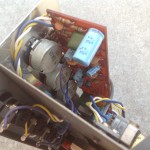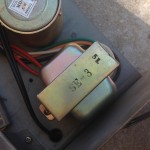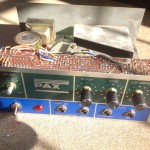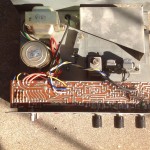It’s been a busy week behind the scenes at Studio Nebula. Not a lot of creative stuff going on at the moment, but I’ve taken the time to give much-needed TLC to some vintage gear.
Tag Archives: gear
Maxim MDS 500 – Photos
The Maxim MDS-500 is not ready for action yet. Honestly, I’m sure it will ever be. It just doesn’t sound very good. I haven’t given up all hope though – I have a couple of suspicions about some things that might not be working as they’re supposed to, but it’s tricky to troubleshoot with no frame of reference. This is the only one of these I have ever seen, I’m not completely sure what it’s supposed to sound like, and there are no schematics or service documents. (If somebody out there has schematics, please let me know!)
Problems I’m having with this MDS-500:
- The “noise” doesn’t seem to be as loud as it should be. (Try to find the noise source, disconnect it from each voice 1 at a time – perhaps one voice is loading it down for some reason. Otherwise, perhaps the noise has an output buffer that is not up to snuff)
- Most of the front panel pots are intermittent, filthy.
- Despite trying lots of settings I haven’t really heard anything that sounds like it’s filtered by an SSM2044 – yet there is an SSM2044 filter per voice!
I’m just not sure yet whether this device needs mods, repairs, or if it’s just crap.
Sequential Multi-Trak (Hi Res Photos)
A photographic exploration
…of my new Sequential Multi-Trak. Planned work:
- Replace the battery
- Install the new Tauntek/Bob Grieb firmware
- Perform battery drain / current draw mod (if necessary)
- Replace buttons which have yellowed over time
- Replace foam in the flight case
The PAX PX-8 Echo Chamber (Tape Delay)
Here’s a new addition to the Studio Nebula family. It’s a “PAX Echo Chamber”.
I can’t find any image or reference to this exact device anywhere on the internet. It appears that this PAX PX-8 is functionally identical to the “SOLEC SE-3″. There are other PAX PX-8 machines with a black face, which appear identical to the SOLEC SE-8. After finding some pictures of the SE-8 on the web, it appears that the black-faced unit offers continuously variable tape speed (delay time) control, while this earlier unit uses a 6-position switch.
Unfortunately for me, on my unit the first 4 positions are all the same speed – meaning my Pax has only 3 possible delay times. I’m not going to try to repair it, I’ll mod it instead.
It sounds surprisingly nice. I expected a lot more noise, and I also expected the echo quality to degrade rapidly if left continuously repeating. I am beyond pleased with how nice it sounds … perhaps even “tickled”.
Still, this unit needs a couple of important modifications:
- Conitnuously variable Tape Speed. The motor is connected to the circuit board with 3 wires. The label says the motor is powered by 13.2 VDC. I think I’ll use a potentiometer wired to a transistor to vary the voltage supplied to the motor.
- Effects loop mode.The dry signal is always present at the output jack, and it’s quite a bit louder than the delayed signal. This is OK for in-line use with an instrument, but not suitable for processing an effect send. I’m thinking the best solution is to add a pot to attenuate the dry signal. This way, I’ll be able to turn the dry signal down to zero for fx loop mode, and if I’m using it in line with an instrument, I’ll be able to get a wetter instrument-to-echo ratio.This echo is in really good shape cosmetically, so I am reluctant to add any controls to the front panel. Replacing the rotary switch with a pot won’t change the device’s appearance, but the “dry level” is an additional control. It is unlikely that anybody would want to adjust the dry level during normal use – I see it as a set-and-forget knob, so I guess I’ll put it on the rear panel, in the cord compartment, near the tape cartridge.
I was quite taken by this cool-looking thing when I first saw it. Still, even though it’s in excellent condition, I think I probably paid too much.
The seller lives in Mississauga, and he reminds me a lot of … me. I hope to interact more with him in the future.
- The PAX PX-8 Echo Chamber Front Panel.
Gear News
SYNTHS RECENTLY ACQUIRED: Ensoniq ESQ-1 and Ensoniq SQ-80.
GEAR RECENTLY REPAIRED: Korg Zero 8 (touchscreen issue) Info here
YOU GOTTA CHECK OUT: the Novation Launchpad Mini. My original legacy Launchpad started acting crazy (“drawing too much power”) and I have a gig tomorrow night. A Novation guy stated on Gearslutz that this is typically due to a hardware fault, but since I have a gig tomorrow night, I just went to Long&McQuade and picked up the new Launchpad Mini for just $99 – after all, I need something schnell! After configuring its bootload option to “Full Power” it looks simply gorgeous. The LEDs look far brighter than the original Launchpad. Better still, unlike its full-sized predecessor it is small enough to perch on the panel of many synths, and thanks to its rubber underlay it won’t slide around. I’m pretty sure I’ll be keeping the Launchpad Mini. Once I repair my original Launchpad I’ll sell it – cheap. The two pics below show how nicely the new Launchpad Mini nestles itself atop the panel of a synth. Click for full size.
FINALLY! I just finished setting up my new, temporary workspace. I took a couple pictures just before I started doing some urgent work on some new material. I still have some oddball boxes and gear to deal with, but at least it’s a workable space. I was able to leave my large-format 24-channel mixer in storage, opting instead for the inputs of the MOTU 828mk2 expanded out to the Behringer ADA8000 via ADAT optical. I can control the mix of all 16 inputs using MOTU’s CueMix FX software from the iPad via TouchOSC. Check these pics out, and click on them to see in HD!

From here you can see most of the keyboards. Leftmost stand, top to bottom: Roland VK-09 organ, Yamaha CS40M synth. Three-tier stand, top to bottom: Roland JX-3P, Roland Juno-106, Roland Jupiter-6 (this is the Killer Roland Rack!) Z-frame station, top to bottom: rack including Yamaha R100 reverb, Alesis Micro Enhancer, Behringer ADA-8000 Ultragain A/D converter, DigiTech DSP128+ processor, Bellari RP-282 compressor; keyboards including Korg DW-6000, Ensoniq SQ-80 (beside Boss RE-20 Space Echo twin pedal), Ensoniq ESQ-1. The desktop rack to its right contains: Emagic Unitor 8, Novation Supernova II, MOTU 828mk2, power bars, Emagic AMT8. Also visible on far right of desk surface (closest to front of photo): Korg Poly-800-II.
















